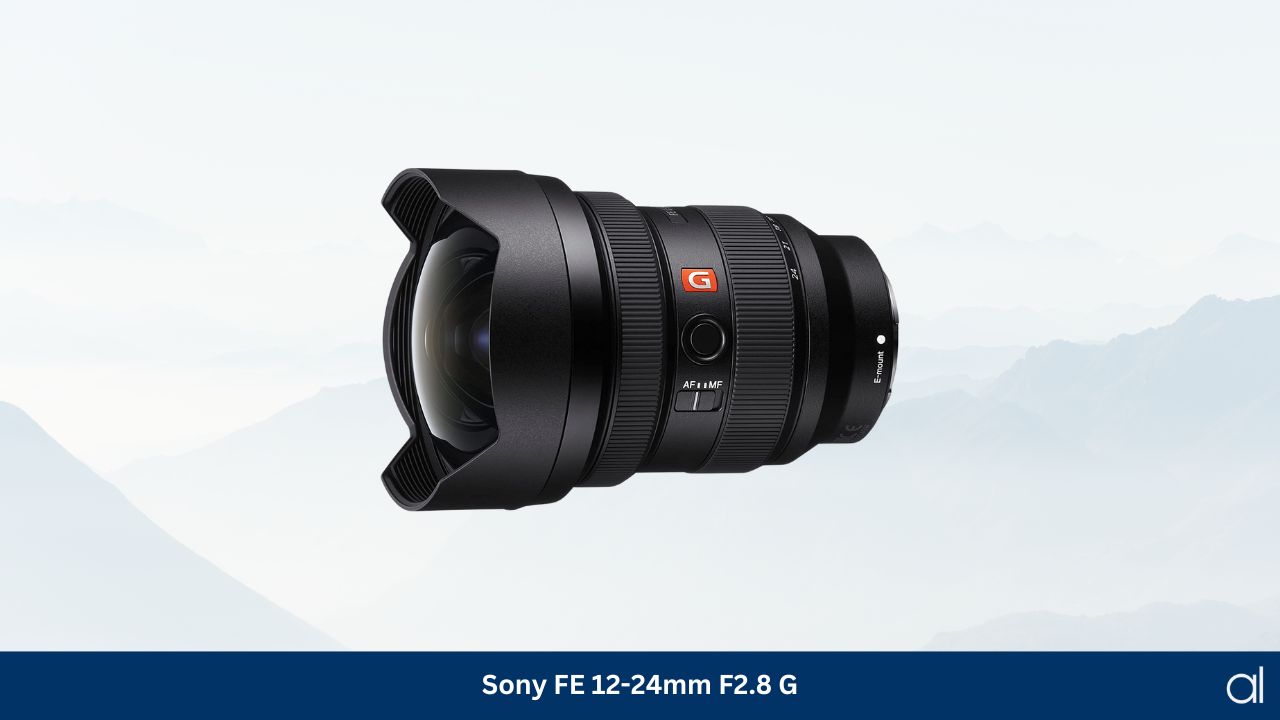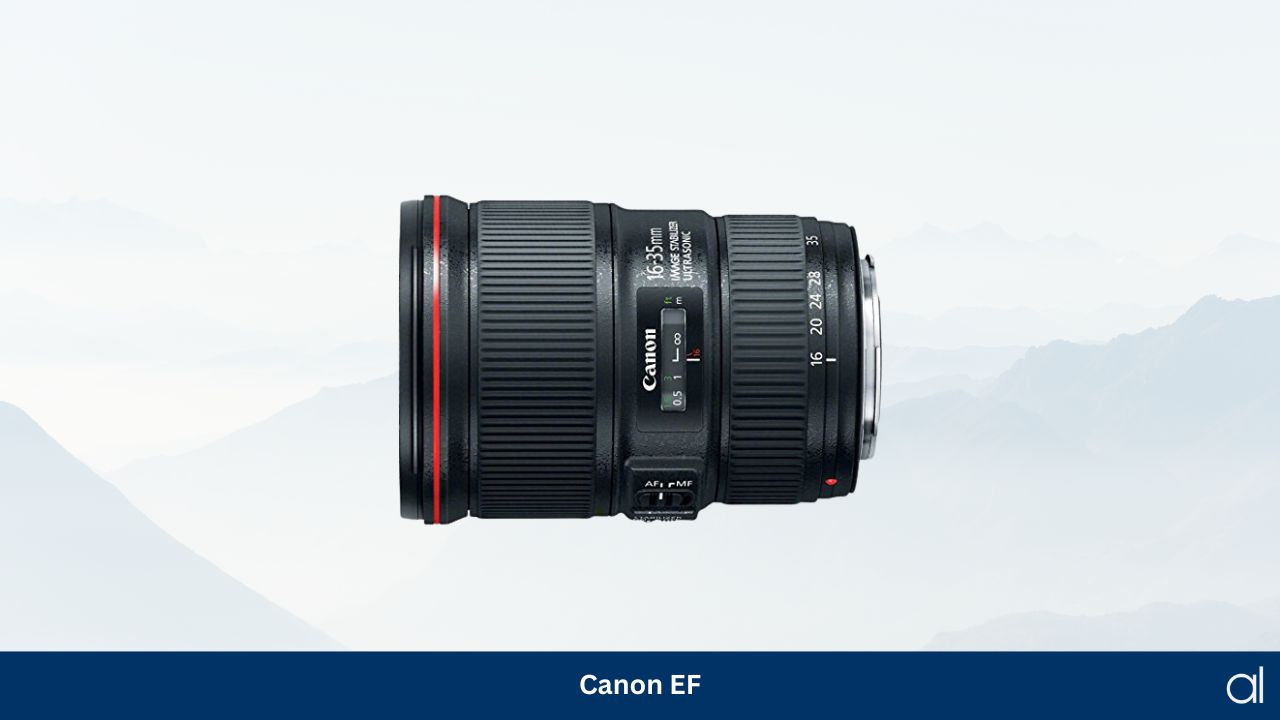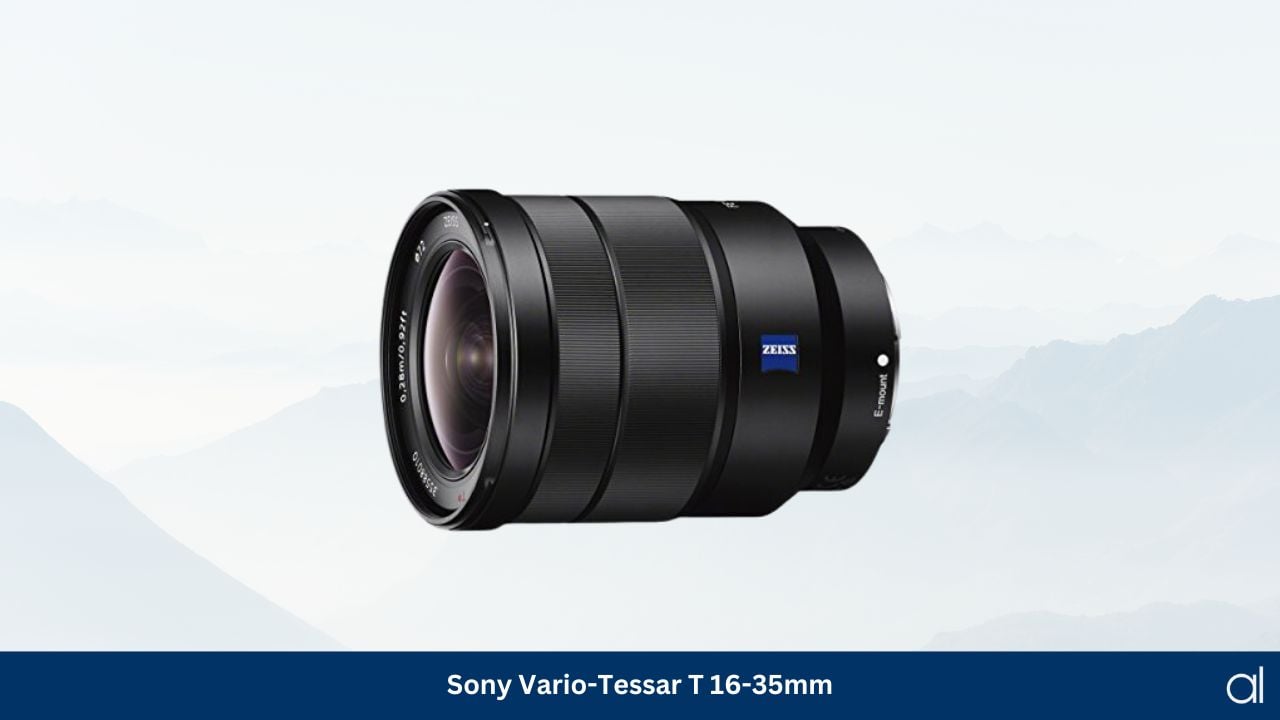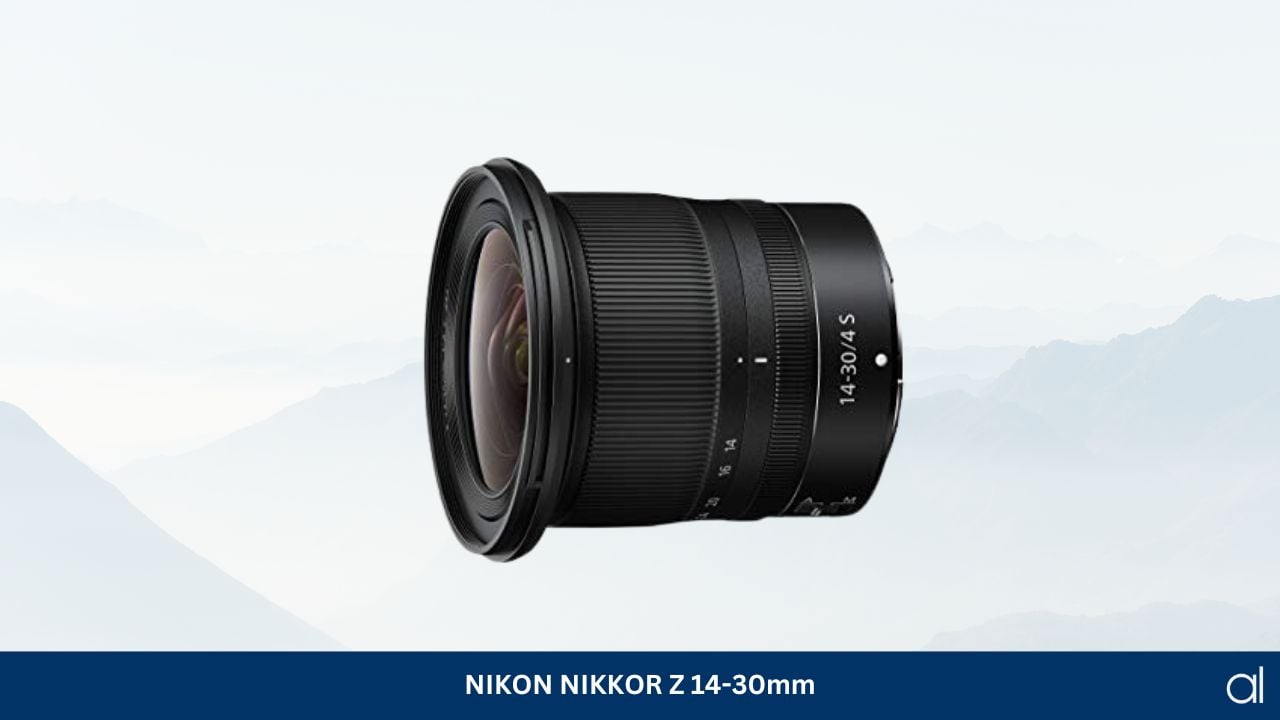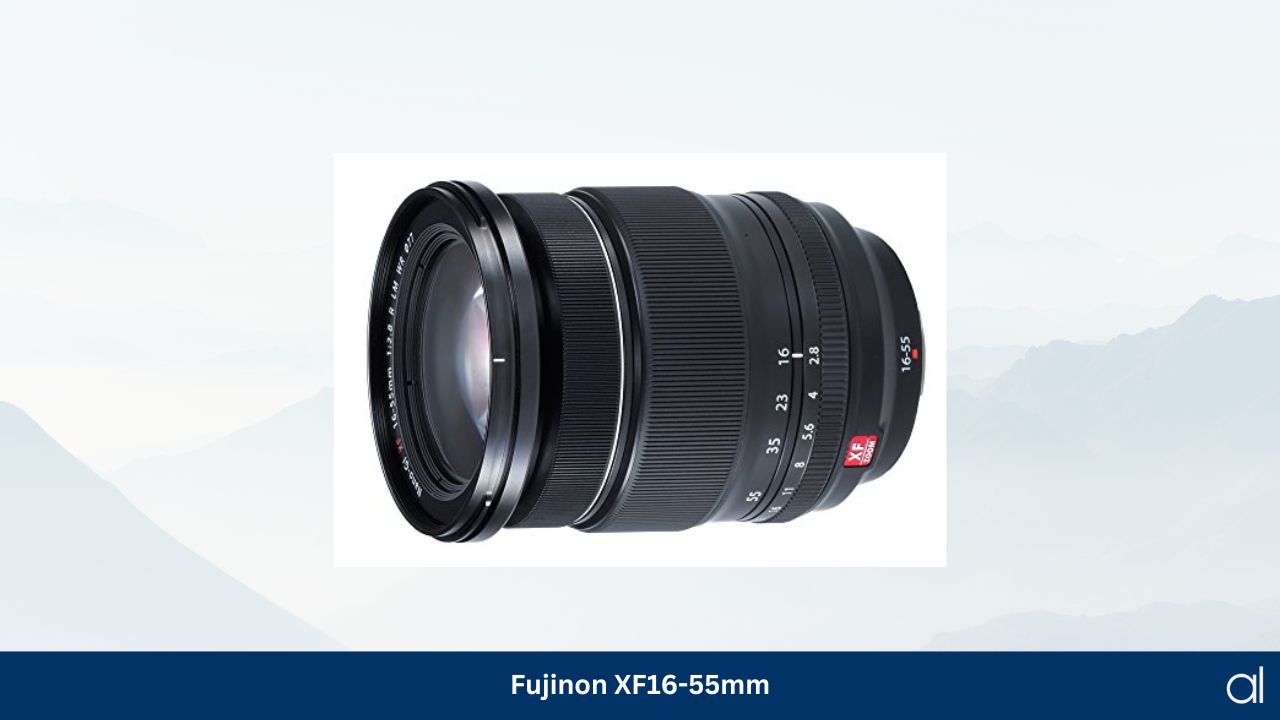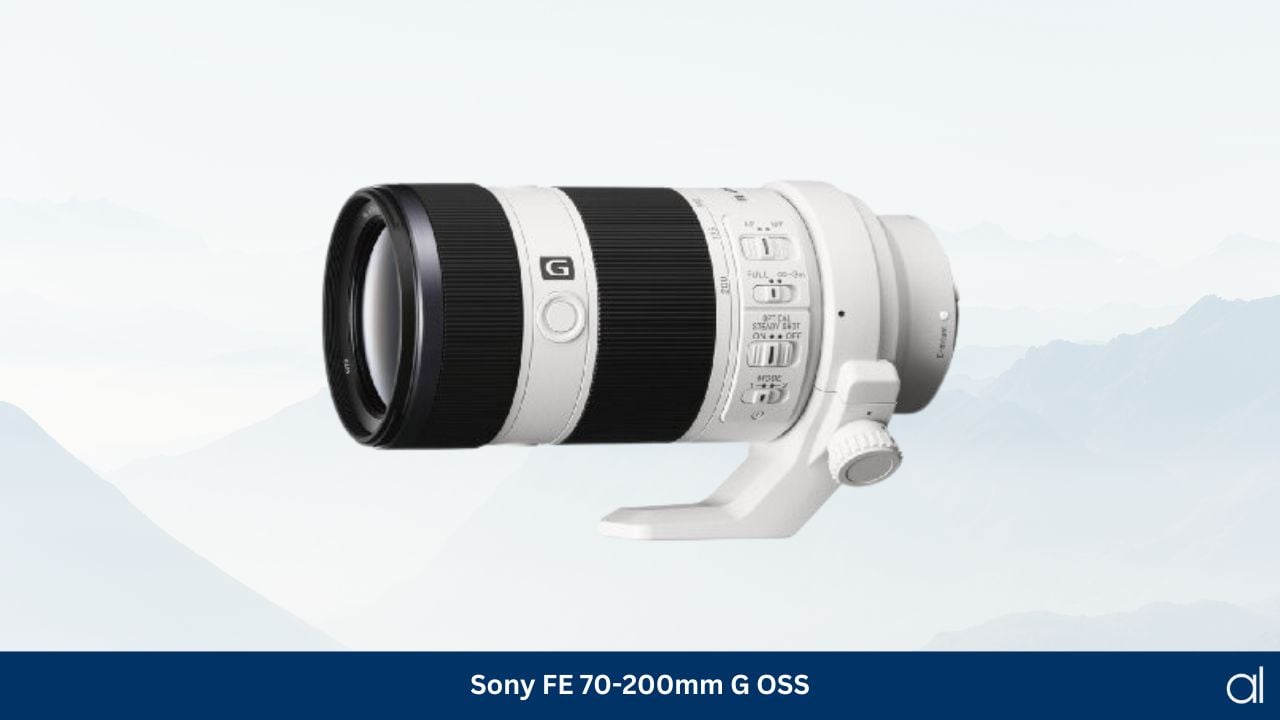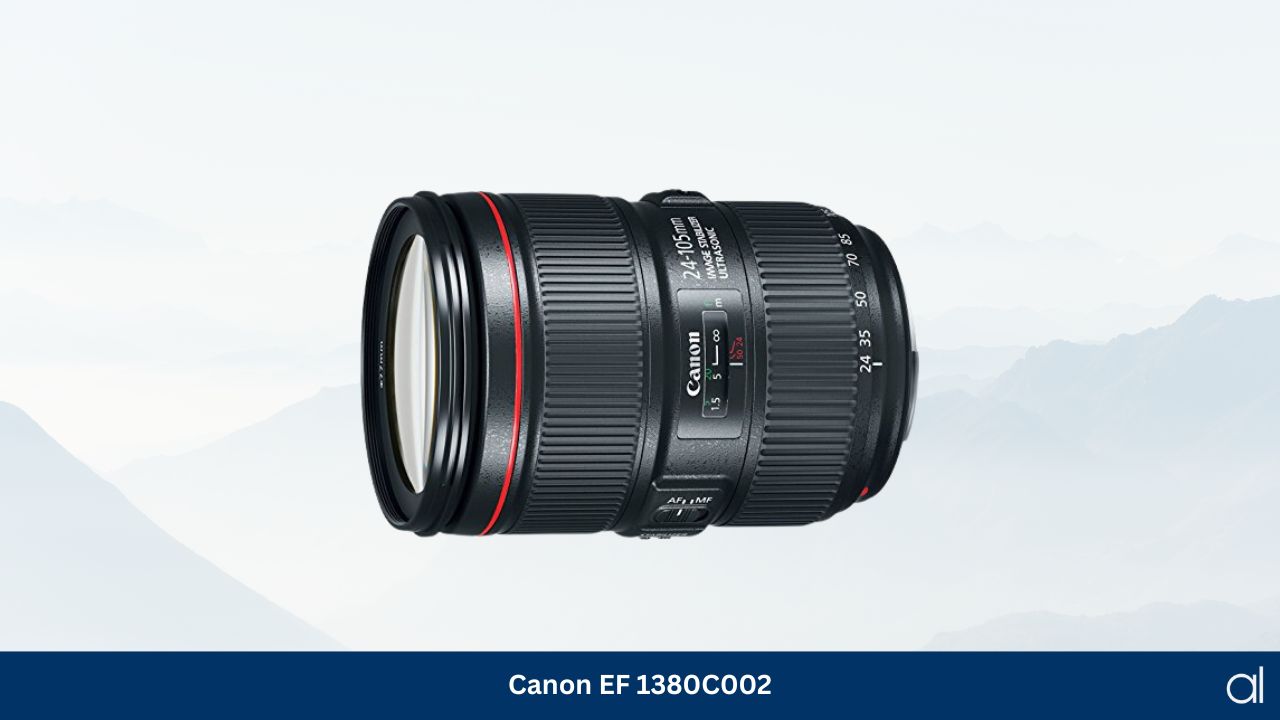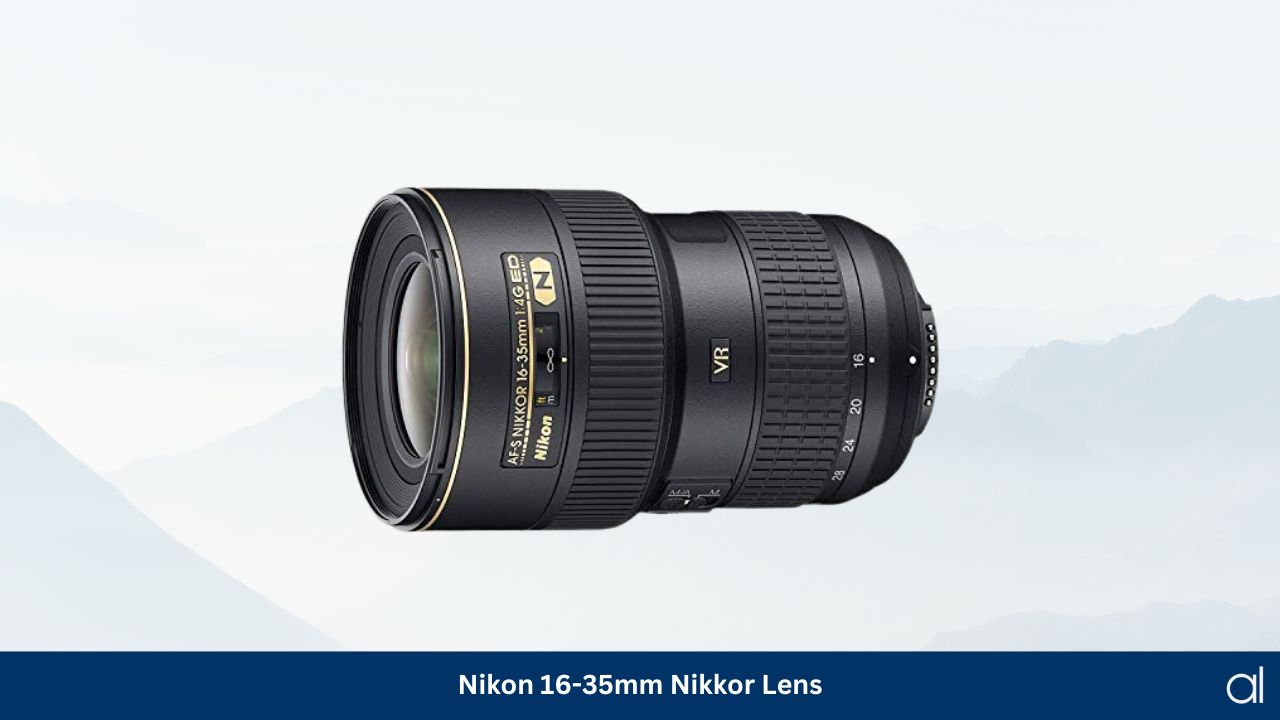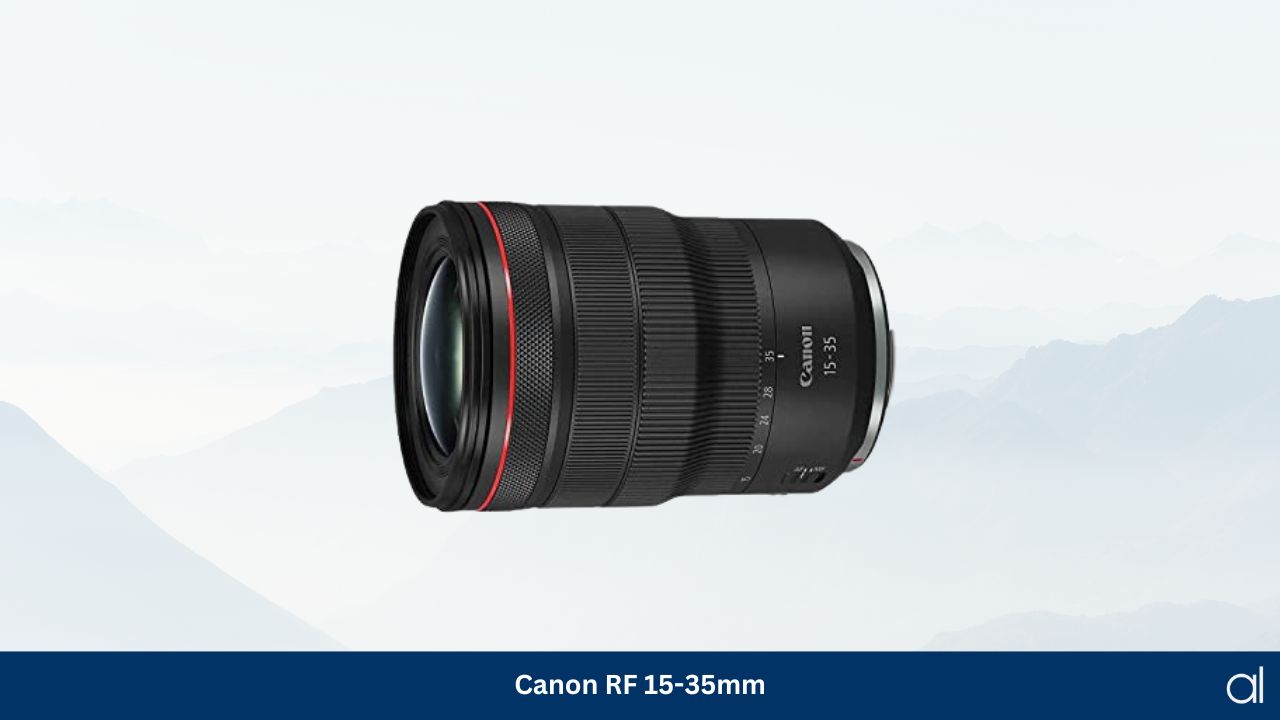Capturing the breathtaking beauty of landscapes demands impeccable precision. Thus, in the realm of landscape photography, the significance of lenses cannot be overstated.
With the perfect lens in your grasp, the landscapes shift and come alive. From the wide-angle embrace to the intimate gaze of telephoto lenses, these lenses hold the power to transform your images into tangible dreams. So, read my article to discover the best lenses for landscape photography.
9 Best Lenses For Landscape Photography
1. Sony FE – Best Landscape Lens For Detailed Shots
When capturing the stunning beauty of landscapes, the Sony FE (SEL1224GM) stands unrivaled. Its impressive range of features and exceptional optical performance make it a true gem for landscape enthusiasts.
Whether you’re capturing sweeping vistas or close-up details, the Sony FE (SEL1224GM) lens delivers image quality that is nothing short of magnificent. The focal length of 12-24mm allows photographers to capture vast landscapes with stunning clarity, while the wide-angled perspective adds depth and dimension to every image. With its ultra-wide zoom lens and constant f/2.8 aperture, this wide-angle lens opens up a world of creative possibilities.
One of the standout features of this wide-angle lens is its edge-to-edge sharpness, ensuring that every corner of your frame is crisp and detailed. The lens optics, crafted with precision and finesse, minimize distortion and aberrations, resulting in images that are true to life. Additionally, the lens incorporates advanced technology to reduce chromatic aberration and maintain exceptional acutance, even in challenging lighting conditions.
Designed with landscape photographers in mind, the Sony FE (SEL1224GM) lens is weather-sealed, ready to face any outdoor adventure. This lens is a reliable companion, whether you’re chasing the perfect sunset or capturing the grandeur of the starry night skies in astrophotography.
Furthermore, the lens is compatible with the Sony E-mount system, making it suitable for full-frame DSLR and APS-C camera bodies. Its versatility enables photographers to explore different camera systems without compromising on the quality of the image.
What I Liked
- High image quality
- Versatile ultra-wide zoom lens
- Constant aperture
- Professional build quality
What I Didn’t Like
2. Canon EF 16-35mm – Best Landscape Photography Lens For Precision And Image Clarity
Capturing astounding landscapes requires a lens that can effortlessly encompass the grandeur of nature. Enter the Canon EF 9518B002 lens, a true masterpiece crafted by Canon Inc. to fulfill the dreams of landscape photographers worldwide.
Best compatible with Canon EF lens mount, this lens stands tall amongst its counterparts, thanks to its remarkable features and stunning image quality. With a versatile zoom range and a focal length of 16-35mm, it excels in capturing wide-angle shots, allowing you to embrace the vastness of the landscapes. Whether shooting majestic mountains or serene seascapes, this lens enables you to frame your vision with precision and authenticity.
One of the standout features of this lens is its exceptional optics. The Canon EF 9518B002 lens boasts superior glass construction, ensuring edge-to-edge sharpness and minimal distortion. Its f/4 aperture delivers an impeccable depth of field control, accentuating the beauty of foreground elements while maintaining a captivating background.
Equipped with an ultrasonic motor (USM), this lens guarantees swift and accurate autofocus, enabling you to seize the perfect moment without delay. Drawing from experience, the built-in optical image stabilizer counteracts camera shake, granting you the freedom to shoot handheld with confidence.
Crafted for the most demanding environments, this lens is weather-sealed with a fluorine coating, protecting it against dust and rain. This means you can embark on your photographic adventures without hesitation, knowing that your gear is safe from the elements.
What I Liked
- High-quality optics
- Versatile focal length
- Weather sealing technology
- Fast and accurate autofocus
What I Didn’t Like
3. Sony Vario-Tessar T 16-35mm – Best For Sharp Edged Wide Shots
Capturing the grandeur of nature requires the perfect lens, and for landscape photographers seeking unparalleled image quality, the Sony Vario-Tessar T 16-35mm stands out as an outstanding choice. This lens offers a wide-angle zoom that caters to the diverse needs of landscape photography, making it a must-have for every serious landscape shooter.
One of the most striking features of this lens is its exceptional optical quality. With a focal length range of 16-35mm, it effortlessly captures expansive wide-angle landscape shots while maintaining the edge sharpness. Whether you’re shooting handheld or using a tripod, the built-in optical image stabilizer of the lens effectively minimizes camera shake, ensuring sharp focus in every frame.
A perfect landscape lens should be versatile, and the Sony 16-35mm excels in this aspect. Its weather-sealed construction allows photographers to brave any elements, making it a reliable companion in challenging outdoor conditions. Furthermore, the minimum focusing distance of the lens of just a few inches ensures captivating close-up shots, adding a touch of creativity to the landscape.
Weighing at a lighter lens weight than many others in its class, this Sony lens is a practical choice for those who prioritize mobility and comfort during their photography expeditions. Additionally, its compatibility with a camera system that has an E-mount broadens its appeal to different photographers.
In terms of performance, the lens exhibits a fixed aperture of f/4, providing consistent exposure throughout the zoom range. Its optical design, incorporating aspherical and extra-low dispersion elements, delivers great image quality with minimal distortion, even at the widest angles. Its corner-to-corner sharpness is truly impressive, rendering every detail with stunning clarity.
What I Liked
- Wide focal length range
- High image quality
- Optical stabilization
- Weather-sealed construction
What I Didn’t Like
4. NIKON NIKKOR Z 14-30mm – Best Landscape Photography Lens For Ultra-Wide Angle Shots
The NIKON NIKKOR Z 14-30mm is a game changer for landscape photographers seeking the perfect lens to capture incredible scenes. With its impressive optical quality and unique features, this lens stands out as a great investment.
One of the best qualities of the lens is its ultra-wide angle range, spanning from 14mm to 30mm, allowing you to capture wide-angle landscape shots easily. Its focal length range provides versatility, surpassing the prime lens and even standard zoom lenses. Whether you desire the expansive vistas offered by wide-angle shots or the ability to zoom in on distant details, this lens has got you covered.
My findings show that this wide-angle lens also acts as a zoom lens and excels in the quality and sharpness of the photograph. The lens design minimizes distortion, ensuring your landscape photos remain true to life. The maximum aperture of f/4 is sufficient for most landscape shooting scenarios, and the optical image stabilizer of the lens is a bonus when shooting handheld or for night photography.
Furthermore, the NIKON NIKKOR Z 14-30mm is remarkably lightweight, making it a fantastic lens to carry in your camera bag during long treks. Unlike its bulky counterparts, this lens won’t weigh you down while still delivering exceptional performance, paired with a Nikon mirrorless camera. Moreover, it’s weather-sealed, providing protection against the elements, making it suitable for outdoor adventures.
What I Liked
- Ultra wide angle lens
- High optical quality
- Compact and lightweight design
- Versatile zoom range
What I Didn’t Like
5. Fujinon XF16-55mm – Best Lens For Durable Build Quality
The Fujinon XF16-55mm is a lens that truly stands out in the realm of landscape photography. Designed specifically for landscape photographers, this lens offers a range of features and capabilities, making it a top contender for anyone seeking the best lens for their landscape shots.
One of the most striking aspects of this lens is its versatility in focal lengths. With a focal length range of 16-55mm, it covers both wide-angle and standard zoom perspectives, eliminating the need for multiple lenses in your camera bag. Whether you capture wide-angle shots or zoom in on distant subjects, this lens has you covered.
Regarding optical quality, the Fujinon XF16-55mm delivers stunning results. Its corner-to-corner sharpness and minimal distortion ensure that your landscape photos are crystal clear and true to life. The f/2.8 fixed aperture of the lens allows for beautiful shallow depth-of-field effects, adding a touch of artistry to your images.
What sets this lens apart from others in this category is its build quality and durability. The Fujinon XF16-55mm is weather-resistant and dust-proof, making it perfect for outdoor shooting in any weather condition. Landscape photographers often find themselves in rugged environments, and this lens is up to the task, providing reliability and peace of mind.
Overall, for those who want the best photograph quality, durability, and versatility, the Fujinon XF16-55mm is a fantastic lens. Plus, this lens is compatible with a wide range of camera bodies with a Fujifilm X lens mount, making it a versatile choice for different camera systems.
What I Liked
- High-quality optics
- Versatile focal range
- Fast and constant aperture
- Weather-resistant and durable construction
What I Didn’t Like
6. Sony FE 70-200mm F4 G OSS – Best For Professional Telephoto Photography
Are you a landscape photographer in pursuit of capturing magnificent vistas? Look no further; the Sony FE 70-200mm G Interchangeable Lens is here to elevate your craft. This lens, renowned among landscape shooters, offers a fantastic blend of features that make it a perfect landscape lens.
The Sony FE 70-200mm G is a telephoto lens that falls within the best lenses for the landscape photography category. Its versatile focal length range and a maximum aperture of f/4 allow you to zoom in on distant subjects while maintaining a great quality of images. Its wide zoom range ensures that you capture every detail with precision.
What sets this telephoto lens apart from other landscape lenses is its impeccable image stabilization, which is crucial for sharp focus in various shooting conditions. Whether traversing rugged terrains or shooting handheld, this lens ensures your images remain crisp and blur-free.
Weighing lighter than similar lenses, the Sony FE 70-200mm G offers excellent mobility without compromising performance. Its minimum focus distance allows you to capture intricate details while still encompassing the grandeur of the landscape.
Based on my first-hand experience, this telephoto zoom lens is compatible with Sony Alpha and full-frame cameras, making it a reliable companion for many photographers. Unlike some wide-angle zoom lenses with a bulbous front element, this telephoto lens offers ease of use, allowing for hassle-free protective or photographic filter attachment.
What I Liked
- Versatile zoom range
- Optical image stabilization
- High image quality
- Compact and lightweight design
What I Didn’t Like
7. Canon EF 24–105mm – Best Landscape Lens For Versatile Zoom Range
The Canon EF 1380C002 is an absolute gem for any photography enthusiast seeking to capture stupendous landscapes. Its exceptional features set it apart from the multitude of lenses available for landscape photography, making it a must-have for those who want to elevate their craft.
One of the standout qualities of this lens is its versatile zoom range, allowing you to effortlessly transition from wide-angle shots to close-ups without compromising the quality of the photograph. Its wide-angle zoom effortlessly captures the grandeur of vast landscapes, immersing viewers in a visual feast. On the other spectrum range, its telephoto range provides the perfect opportunity to focus on intricate details, capturing the essence of your subject with remarkable clarity.
What makes the Canon EF 1380C002 exceptional is its unrivaled image quality. Equipped with Canon’s renowned L-series glass, this lens delivers stunningly sharp images with rich colors and exceptional contrast. Whether shooting in low light conditions or under the glaring sun, this lens consistently performs, ensuring your landscapes are brought to life with vivid realism.
Another notable advantage of this Canon L lens is its lightweight construction, making it an ideal companion for photographers seeking mobility. It weighs less than many comparable lenses in its class, offering unparalleled convenience and reducing strain during long shooting sessions.
What I Liked
- Robust build quality
- Excellent image quality
- Efficient image stabilization
- Versatile zoom range
What I Didn’t Like
8. Nikon 16-35mm Nikkor Lens – Best Landscape Photography Lens For ED And VR Technology
If you’re an avid landscape photography enthusiast seeking to capture stunning landscapes, the Nikon 16-35mm is a must-have addition to your arsenal. This wide-angle zoom lens effortlessly elevates your landscape shots, showcasing the magnificence of nature with remarkable clarity and detail.
One of the standout features of this lens is its exceptional focal length range of 16-35mm, which strikes a perfect balance between capturing expansive vistas and highlighting intricate details. Whether you’re capturing the majestic sweep of rolling hills or the delicate texture of blooming flowers, this wide-angle lens ensures that every element is rendered accurately.
In terms of optical quality, Nikon has spared no expense. The lens boasts advanced lens elements, including Extra-low Dispersion (ED) glass, which minimizes chromatic aberrations and ensures accurate color reproduction. As a result, your landscape photos will be rich in vibrant hues, true to the scene you witnessed.
This lens also incorporates Vibration Reduction (VR) technology, a true game-changer for handheld landscape or wildlife photography. It counters camera shake, allowing you to capture razor-sharp images even in challenging lighting conditions. The VR feature proves particularly invaluable during those golden hour moments, enhancing your ability to freeze the fleeting beauty before you. So, pair it with a photographic filter, and take the landscape photograph you’ve only seen in magazines!
When it comes to portability, this Nikon lens is a standout. Weighing in at a remarkably lighter weight than its counterparts, it ensures your equipment doesn’t slow you down on your photographic explorations. Its compact design also makes it ideal for travel, fitting comfortably inside your camera bag alongside your other gear.
What I Liked
- Constant aperture
- VR technology
- ED glass
- High-quality image
What I Didn’t Like
9. Canon RF 15-35mm – A Landscape Photography Lens Best For Easy Portability
Introducing the Canon RF 15-35mm, a camera lens that effortlessly captures the beauty of nature, making it an ideal companion for any avid photographer seeking to elevate their landscape photography. This fantastic lens combines innovation and precision to deliver awe-inspiring results.
What sets the Canon RF 15-35mm apart from its counterparts is its remarkable versatility. With a focal length ranging from ultra-wide 15mm to wide angle 35mm, it covers a broad spectrum of perspectives, allowing you to experiment with different compositions and unleash your creativity. Whether you’re shooting expansive landscapes or detailed close-ups, this lens covers you.
Weighing in at a light and manageable size, the Canon RF 15-35mm won’t weigh you down during those long hikes to find the perfect vantage point. Moreover, its compact design is combined with image stabilization technology. They ensure that you can confidently capture those awe-inspiring vistas without compromising the quality of the images or suffering from the shaking of the camera.
In a world saturated with options, finding the best lenses for landscape photography can be daunting. However, after giving it a go, we’ve found that the Canon RF 15-35mm is one of the best lenses for landscape photography. With its exceptional versatility, superior quality of images, and lightweight construction, this lens is a must-have for any photographer passionate about capturing the beauty of nature.
What I Liked
- Wide angle of view
- High-quality optics
- Bright aperture
- Easy portability
What I Didn’t Like
Best Lenses for Landscape Photography Comparison Table
| Best Lenses | Lens Type | Maximum Focal Length | Minimum Focal Length | Item Weight |
|---|---|---|---|---|
| Sony FE (SEL1224GM) | Wide Angle | 24 Millimeters | 12 millimeters | 1.87 lbs |
| Canon EF 9518B002 | Wide Angle | 35 Millimeters | 16 Millimeters | 1.36 lbs |
| Sony Vario-Tessar T 16-35mm | Wide Angle | 35 Millimeters | 16 Millimeters | 1.14 lbs |
| NIKON NIKKOR Z 14-30mm | Wide Angle | 30 Millimeters | 14 Millimeters | 1.07 lbs |
| Fujinon XF16-55mm | Normal | 55 Millimeters | 16 Millimeters | 1.44 lbs |
| Sony FE 70-200mm G OSS | Telephoto | 200 Millimeters | 70 Millimeters | 1.84 lbs |
| Canon EF 1380C002 | Normal | 105 Millimeters | 24 Millimeters | 1.75 lbs |
| Nikon 16-35mm Nikkor Lens | Wide Angle | 35 Millimeters | 16 Millimeters | 1.50 lbs |
| Canon RF 15-35mm | Wide Angle | 35 Millimeters | 15 Millimeters | 1.85 lbs |
Buying Guide For The Best Lenses for Landscape Photography
When capturing wondrous landscapes, having the right and the best lens is essential. Here are fifteen important features every landscape photographer should keep in mind before buying one:
1. Wide Angle Focal Length
A lens with a wide-angle focal length is indispensable for capturing vast landscapes. It allows you to encompass a broad field of view, encompassing sweeping vistas and magnificent scenery.
With a wider perspective, you can convey the sense of scale, depth, and grandeur that characterizes stunning landscapes. Whether it’s a mountain range, a serene coastline, or a sprawling forest, a wide-angle lens ensures you can fit expansive scenes into your frame, providing an immersive experience to viewers.
2. High Optical Resolution And Sharpness
Optical resolution and sharpness are crucial factors in landscape photography, as they determine the clarity and fine details in your images.
A lens with high optical resolution ensures that even the subtlest textures, intricate patterns, and distant elements in the scene are rendered with exceptional clarity. This feature guarantees that every minute detail, be it the delicate branches of a tree or the texture of rugged rocks, is captured accurately. It enhances the overall visual impact and sense of realism in your photographs.
3. Low Distortion
Minimizing distortion is vital in landscape photography to achieve accurate and undistorted renditions of the scene. A lens with low distortion ensures that straight lines remain straight and objects retain their natural proportions.
This characteristic is particularly important when photographing architectural landmarks, where distortion can be visually distracting. By preserving the true geometry of the scene, a lens with low distortion allows viewers to appreciate the authenticity of the landscape, contributing to a pleasing and harmonious visual representation.
4. Edge-To-Edge Sharpness
Edge-to-edge sharpness refers to the uniformity of sharpness across the entire frame of an image. In landscape photography, achieving good edge-to-edge sharpness is crucial to maintain the integrity of the scene and ensuring that all elements, from foreground to background, are equally in focus.
A lens with excellent edge-to-edge sharpness eliminates the need for extensive post-processing adjustments. It ensures that even the corners of your images possess the same level of clarity and detail as the center. This feature enables viewers to explore the image freely, without any distractions caused by soft or blurry images.
5. Aperture Range For Different Lighting Conditions
Landscape photography often involves shooting in a wide range of lighting conditions, from the soft hues of sunrise or sunset to the harsh midday sun. Choosing a lens with a versatile aperture range allows you to adapt to these various lighting scenarios effectively.
A wider aperture, such as f/2.8 or larger, facilitates low-light photography, ensuring you can capture stunning landscapes during the golden hour or in dimly lit environments. On the other hand, a narrower aperture, such as f/16 or smaller, enables you to achieve great depth of field, keeping both the foreground and background in sharp focus.
This flexibility empowers you to artistically control the exposure and depth of field, translating your creative vision into captivating landscape photographs.
What are the best lenses for street photography?
Prime lenses with wide apertures like Sony’s 35mm f/1.8, Nikon’s 50mm f/1.4, or Canon’s 35mm f/1.4L capture candid moments with sharpness. They also capture beautiful bokeh during a street photography session.
Which lenses are recommended for architectural photography showcasing stunning structures?
Wide angle lenses like Canon’s 16-35mm f/2.8 III or Nikon’s 14-24mm f/2.8G provide broad perspectives, minimize distortion, and are ideal for architectural photography.
What protection filters should I use for my lenses to safeguard them during outdoor shoots?
High-quality UV protection filters like Hoya’s UV Pro1 Digital or B+W’s UV Haze MRC filters provide a layer of protection, shielding your lens from dust, scratches, and UV rays.
Which lenses are recommended for capturing the intricate details and vibrant colors of artworks?
Macro lenses like Sony’s 90mm f/2.8 G OSS, Nikon’s 105mm f/2.8G VR, or Canon’s EF-S 60mm f/2.8 Macro USM offer exceptional close-up capabilities. They are perfect for photographing artwork with stunning clarity.
What are the best professional lighting kits for photography, ensuring consistent illumination?
Continuous lighting kits like Godox’s AD200 Pro or Profoto’s B10 provide powerful, portable, and adjustable lighting options, enabling you to achieve consistent and desired illumination for your shots.
Can lighting kits enhance the quality of one’s building photography?
Absolutely. Proper lighting kits like softboxes and strobes can add depth, eliminate shadows, and accentuate architectural features to enhance one’s building photography.
Conclusion
Among photographic lenses, the Sony FE (SEL1224GM) emerges as a formidable contender, enchanting photographers with its stunning optics and constant aperture. Meanwhile, the Canon EF (9518B002) beckons with its L-series prowess, offering remarkable quality images and reliable image stabilization.
However, for those seeking a versatile companion, the Sony 16-35mm Vario-Tessar T delivers with its excellent build quality and optical stabilization.
These wide-angle and zoom lenses, united by their ultra-wide focal ranges, excel in capturing expansive scenes, allowing photographers to unleash their artistic prowess and amplify visual narratives. As we traverse the vast landscapes of creativity, these lenses become steadfast companions, paving the way for extraordinary visual storytelling.
Related Articles
5 Best Lenses for Street Photography
7 Best Lenses for Building Photography
13 Best Continuous Lighting Kits for Photography
6 Best Protection Filters for Lenses
7 Best Canon Lenses for Architectural Photography
7 Best Sony Lenses for Architecture Photography

